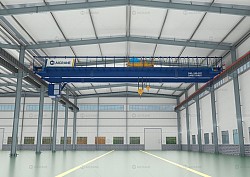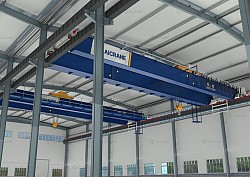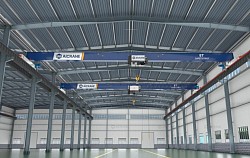When investing in a bridge crane system, one of the most important considerations—beyond the base crane specifications—is how optional features can enhance functionality, safety, and cost-effectiveness over the long term. These optional features may add to the upfront price, but many provide excellent value through improved productivity, extended equipment life, and reduced maintenance costs.
This article outlines key optional features for bridge cranes that deliver the best value for the investment and explains how each one contributes to operational efficiency, safety, and return on investment (ROI).
Key Optional Features for Bridge Cranes
1. Variable Frequency Drives (VFDs)
Why it adds value:
Variable Frequency Drives control the motor speed and torque of bridge cranes, enabling smoother acceleration and deceleration. This reduces mechanical stress on the crane structure and components, extends lifespan, and improves load handling precision.
Benefits:
Reduced mechanical wear and tear
Increased energy efficiency
Smoother movement reduces load swing
Improved safety and operator control
ROI Factor:
By minimizing strain on motors and gearboxes, VFDs significantly reduce long-term maintenance and repair costs while improving handling efficiency-especially valuable in high-use environments.
2. Remote Control Systems
Why it adds value:
Wireless remote controls allow operators to control the crane from a safe distance, improving visibility and safety during lifting operations.
Benefits:
Keeps operators out of hazardous zones
Increases visibility and positioning accuracy
Improves operational efficiency by reducing the need for multiple operators
ROI Factor:
Although it’s an added bridge crane cost over pendant control, a remote control system reduces labor time and risk of injury, offering both operational and safety ROI.
3. Anti-Sway Technology
Why it adds value:
Anti-sway systems help automatically stabilize the load during motion, preventing dangerous or inefficient swinging.
Benefits:
Enhances load control
Reduces the risk of collisions or dropped loads
Improves cycle times by allowing faster, more confident operation
ROI Factor:
This technology is particularly valuable in operations requiring high precision or in facilities with tight clearances. It can significantly reduce product damage and enhance safety.
4. Load Display and Weighing Systems
Why it adds value:
These systems provide real-time load weight information directly to the operator, helping ensure lifts are within the crane’s safe working limits.
Benefits:
Prevents overload accidents
Improves compliance with safety regulations
Reduces liability risks
ROI Factor:
Accurate load monitoring minimizes equipment stress and potential damage while helping meet regulatory compliance-saving you from costly fines and downtime.
5. Radio Frequency Identification (RFID) and Automation Integration
Why it adds value:
RFID systems can be used to track and identify lifted loads, helping integrate crane operations into smart warehouse or manufacturing systems.
Benefits:
Automated inventory management
Reduced human error
Improved traceability and process transparency
ROI Factor:
Best suited for modern smart factories, this option helps streamline operations and reduce manual input, contributing to lean manufacturing and Industry 4.0 goals.
6. Maintenance Platforms and Walkways
Why it adds value:
Maintenance walkways and platforms allow safe and easy access to crane components for routine inspection and repairs.
Benefits:
Reduces downtime during service
Ensures safety of maintenance personnel
Facilitates compliance with safety standards
ROI Factor:
These additions may increase upfront structural cost but significantly reduce service downtime and risk of accidents during maintenance.
7. Explosion-Proof or Weatherproof Design (for Specialized Environments)
Why it adds value:
In industries like petrochemicals, mining, or outdoor applications, customized explosion-proof or IP-rated weatherproof components are essential.
Benefits:
Ensures safe crane operation in hazardous environments
Protects electrical components from corrosion and moisture
Increases equipment lifespan in harsh conditions
ROI Factor:
These features are critical in specialized environments and prevent costly accidents or equipment failure, delivering massive long-term value and regulatory compliance.
8. Dual Trolley or Dual Hoist Configuration
Why it adds value:
Having two trolleys or hoists on a single bridge enables more flexible handling of oversized or heavy items and synchronized lifting.
Benefits:
Enables tandem lifting
Improves handling of long or complex loads
Reduces need for additional cranes or equipment
ROI Factor:
This feature improves productivity in operations that handle large, irregular loads-saving time and reducing the need for manual repositioning or external handling devices.
9. Crane Condition Monitoring Systems
Why it adds value:
Real-time monitoring systems collect and transmit data on crane usage, wear, and operational conditions.
Benefits:
Enables predictive maintenance
Helps reduce unplanned downtime
Allows better planning for repairs and replacements
ROI Factor:
Predictive maintenance reduces unexpected breakdowns, extends equipment life, and can lower overall maintenance costs by up to 30%.
10. Soft Start Technology
Why it adds value:
Soft start systems reduce the initial surge of current and mechanical impact when motors start, protecting both the electrical system and mechanical components.
Benefits:
Extends motor lifespan
Improves handling smoothness
Reduces voltage drops in facility electrical systems
ROI Factor:
Especially valuable for high-capacity bridge cranes, soft start technology decreases operational stress and helps reduce electricity costs over time.
11. Automatic Crane Positioning and Zoning Systems
Why it adds value:
Automated positioning systems allow cranes to move to pre-set locations with the push of a button, improving efficiency and consistency in repetitive operations.
Benefits:
Improves accuracy in material placement
Reduces operator fatigue
Minimizes human error
ROI Factor:
Highly beneficial in production lines and warehouses, these systems can dramatically improve cycle times and consistency.
12. End Travel Limit Switches and Zone Limits
Why it adds value:
Limit switches help prevent over-travel of the trolley or bridge, while zone limits create restricted areas where crane movement is limited.
Benefits:
Prevents collisions with equipment or personnel
Enhances safety in shared workspaces
Protects building structure and machinery
ROI Factor:
Protecting infrastructure and machinery helps avoid catastrophic accidents or expensive repairs, making it a valuable investment in any facility.
Conclusion
While standard bridge crane configurations meet many basic lifting needs, integrating the right optional features can transform your crane into a highly efficient, safe, and intelligent lifting solution. The key to maximizing value is selecting options that align directly with your operational demands and long-term cost reduction goals.
To get the most out of your investment, work closely with your bridge crane supplier or manufacturer to assess your workflows, environment, and performance expectations. A modest additional investment in the right features can result in significant savings, improved safety, and enhanced productivity over the life of the crane.



